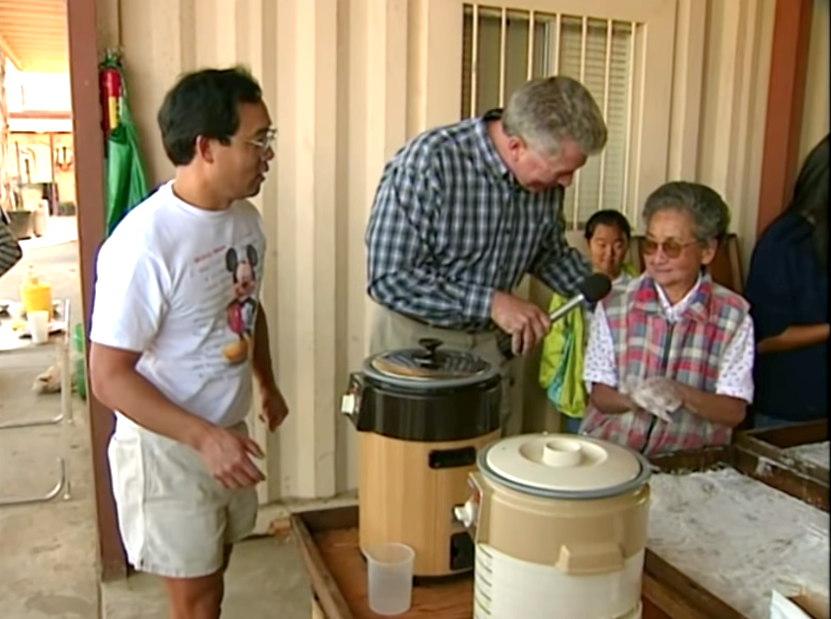The Stellar Life of Stella Otsuka
By Gwen Muranaka
“Progress! Things gotta keep moving!”
Stella Otsuka said with energy and optimism as Huell Howser interviewed her in 2002. It was the third time the famed broadcaster had spoken with the Otsuka family for his acclaimed “Visiting…With Huell Howser” series on public television.
At the time, Stella was reflecting on the end of an era: the closure of Otsuka Farms. But moving defines Stella, a city girl who grew up in Sacramento and eventually settled in Santa Ana to run a successful farm and roadside stand, known for its fresh vegetables and large, sweet strawberries. The rich sandy loam soil along the banks of the Santa Ana River was ideal to grow berries. Now 98 years old, Stella laughed, remembering how Howser grabbed one to take a bite.
Born on October 9, 1923 in Sacramento to Tohei and Kayo Fujimoto, Stella was raised in what she describes as a “barrio” where people of all ethnicity’s lived. Her father worked as a farm laborer out in the country, while her mother worked in the Del Monte Foods and Hunts canneries.
“All Japanese worked in canneries. It was seasonal.
When the season was over, they would get unemployment. Summertime was peaches and fruits. Wintertime was tomatoes,” Stella said. The family was large with four children, as well as three stepbrothers and one stepsister. Stella had already graduated from high school and had plans to attend business school when Japan bombed Pearl Harbor on Dec. 7, 1941.
With the signing of Executive Order 9066, her family, like 120,000 other people of Japanese descent – two-thirds of them U.S. citizens -- were forced to leave their homes on the West Coast.
She carried a typewriter among her belongings and the family first went to Walerga Assembly Center, located north of Sacramento, one of 12 assembly centers where Japanese Americans were detained while the wartime detention centers were being built. The family volunteered to go early and helped set up the camp in April 1942.
She recalled that an African American family that lived in their same building visited them at Walerga. In the summer, the family was sent to Tule Lake, where Stella played baseball in the open field.
1944: Amache Incarceration Camp - Block 7 - Stella with her cousins
In winter 1943, the War Relocation Authority launched the infamous loyalty questionnaire. Those who answered “no-no” to questions 27 and 28, were deemed “disloyal” and were segregated in Tule Lake.
“When Tule Lake became a camp for ‘no-nos,’ we were asked to move out,” Stella said.
“We could pick any camp. We had an aunt and uncle who were in Amache and there was an empty apartment. So they told us to go there.” The family lived in Block 7 at Camp Amache in Colorado. Stella got a job as a bookkeeper in the administration building. Her brothers George and Tom served in the Military Intelligence Service in Fort Snelling, Minnesota. Stella was given permission to leave Amache to go to Minnesota, where she worked as a housekeeper.
1945 - Minnesota school of business
It was on her first day in Minnesota that she met her future husband, Joe Kenji Otsuka, who enlisted into the U.S. Army at the age of 19 after graduating from Downey High School and served as a translator alongside her brothers.
“He came to the train station. They were all buddies,” she remembered.
When they were to ship out to Japan to serve as interpreters, Otsuka recalled Joe asking her a very important question. “Joe said, ‘Let’s get engaged.’ I said, ‘Nothing doing. You go and come back and we’ll make up our mind.’ After they shipped out, I went to the business school,” Stella said.
She attended the Minnesota School of Business and Stella vividly remembers the day the war ended on Aug. 14, 1945.
“We were in school and loudspeaker said, ‘War ended!’” she recalled. Then, she said, the students poured into the streets, shouting ‘War is over! War is over!’ -- but a lot of older people said it wasn’t over “until the boys come home.”
Joe was discharged from the Army and the couple married in March 1947 at Nishi Hongwanji Buddhist Temple in Little Tokyo. The couple moved into an old farmhouse owned by the Kitajima family in Garden Grove where they worked in the fields.
They saved money to buy four acres of land in Santa Ana. Their first son, Donnie, was born on the farm in 1948, followed by Jimmy in 1952 They grew vegetables including tomatoes, green beans, zucchini, cabbage and cauliflower.
Joe made the decision to switch from mixed vegetables to strawberries. Jimmy explained that many Japanese American farms turned to strawberries, which they could sell at a better price.
Donny
Donnie and Jimmy, from when they were a young age, worked on the family farm. “There was no off season. My brother and I couldn’t wait for school to start. We had no summer vacation,” Jimmy said. “I had to deliver our produce to markets, mom and pop stores in a pick-up truck.”
He said the hardest crop to harvest was tomatoes, which had to be sorted and waxed.
Through it all, Stella was at the heart of the operation, working in the fields, managing the books and raising the family. She recalled that her father-in-law, who lived with them, was stern and a “typical Issei man.”
Jimmy
Joe’s parents Yoshitaro and Tsuma Otsuka immigrated from Fukuoka, Japan and settled in Southern California. At first the entire family lived in a small shack, but eventually the family built a larger house on the property in the early 1960s.
Stella’s day wasn’t over when the farm work was done.
“I tried to quit about five every day. I would cook, wash clothes, clean,” Stella said.
“Father-in-law was tough. He would say, a man’s work is outside, woman’s work is inside. My husband got bawled out for taking dishes to sink.”
Stella and Joe retired from farm duties around 1987, per Jimmy’s request. After retirement, she enjoyed caring for her grandchildren.
Otsuka Farms was known throughout the region for its fresh vegetables and strawberries.
In 1988, they opened their “super stand” in Santa Ana. Over the years Otsuka Farms was an important gathering place. Howser visited Otsuka Farms in 1998 as the Orange Coast Optimist Club held their annual mochitsuki. Viewers on television could see OCO members swing wooden mallets to pound sweet rice. In another area, Stella led volunteers who formed the rice into mochi.
Ken (Joe’s Brother), Joe, Yoshitaro, Stella, Donnie, and Tsuma Otsuka
1960: Joe, Stella, Donnie, Jimmy with Stella’s Dad, Tohei
Stella and Joe with Diane, Jimmy, Donnie, Rosa and their grandchildren a the time, JJ, DeeDee, Rodney and Justin
“It tastes better because you have to work for it!” Stella told Howser as she swiftly rounded the molten rice into perfect mochi.
Joe passed away in 1997. Jimmy said that as his father aged, their roles reversed. “When dad quit driving it flip flopped, she was the aggressor. He was a church mouse,” Jimmy said.
Howser returned to Otsuka Farms two more times, to report on the farm’s strawberry crop and super stand, and a final time in 2002 to report on the farm’s closure.
Otsuka Farms was sold to the City of Santa Ana in 2002. “The timing was right. Otsuka Farms was turned into a maintenance facility for the school district,” Jimmy said.
Jimmy brought his expertise to Tanaka Farms in Irvine, where he has worked as the grower since 2005. The legacy of Otsuka Farms can be seen and tasted today in the bountiful produce and strawberries at Tanaka Farms.
Stella lived on the farm until 2003, when she moved into a house on the same block as Jimmy and his family. Today she lives at an assisted living facility nearby and enjoys reading and spending time with her seven grandchildren and 12 great-grandchildren.
In October 2022 Stella will turn 99 years old!
Stella with her great grandchildren
Stella with Jimmy’s family
Ironically, even though her family grew vegetables, Stella says she doesn’t particularly care for them or enjoy cooking with them.














